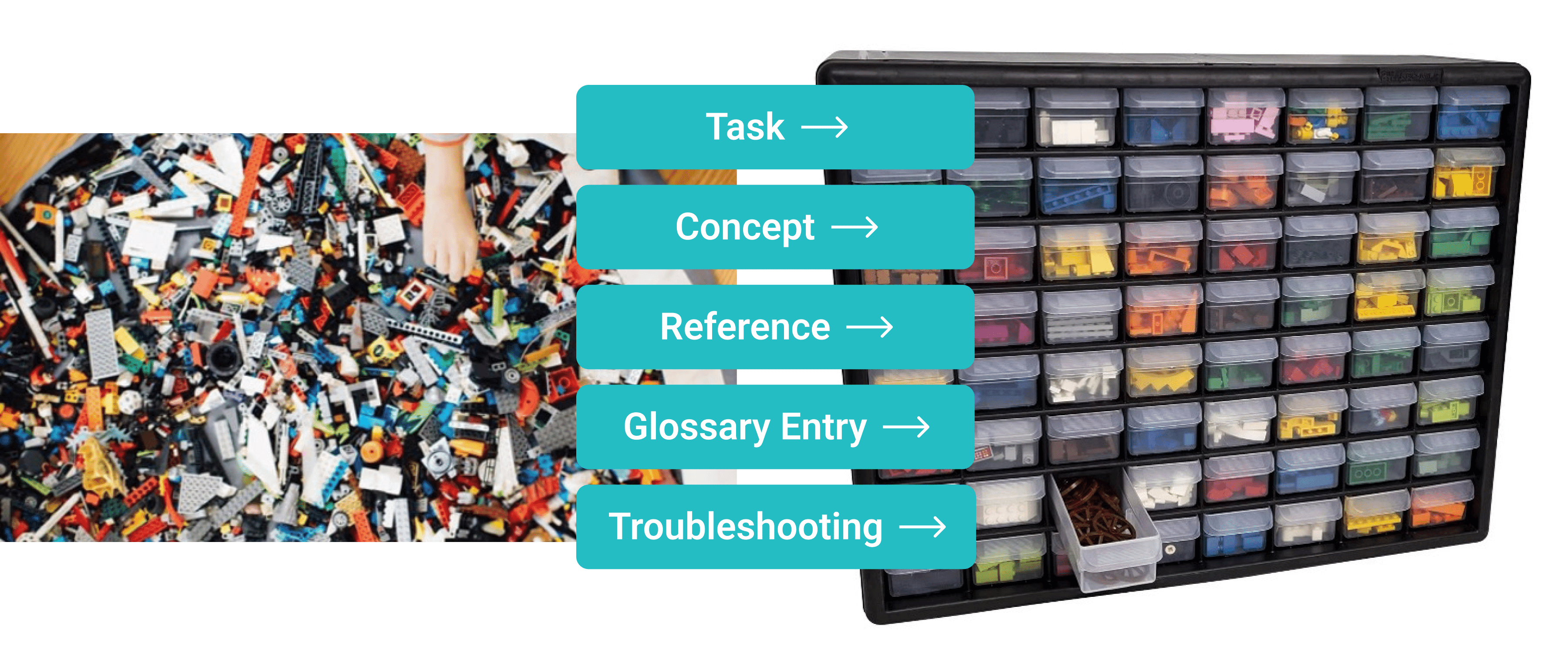DITA isn't a content management system itself. It's an important XML framework and open standard for writing, producing, and delivering technical documentation. The architecture allows you create modular and reusable content that is easy to adapt and repurpose across platforms and formats. By using a topic-based approach, DITA helps organizations keep technical documentation consistent, precise, and user-friendly while maintaining a level of accuracy that is difficult to manage manually.
What is DITA?
The Duplo and Lego Bricks Analogy
The Darwin Information Typing Architecture (DITA) has emerged as an indispensable solution for organizations seeking to create and manage content that is not only sustainable but also highly scalable and adaptable to evolving needs. To truly understand how DITA achieves this remarkable feat, it is essential to grasp the fundamental principles that underpin this open standard. By drawing an analogy between its modular and reusable components, and Duplo and Lego bricks—each serving a unique and vital role in constructing the future of content management—I aim to explain the key tenets that make DITA a gamechanger for medium and large organizations determined to futureproof their operations, streamline regulatory compliance processes, ensure comprehensive traceability, and enhance efficiency and consistency across all facets of content creation and management.
DITA's modular approach to content creation and management is akin to building with Lego bricks. These colorful and robust components form the bedrock of a cohesive and adaptable content strategy. Just as each Lego brick serves a specific purpose in laying the groundwork for more intricate structures, DITA's core elements establish a solid foundation upon which to construct a seamless and scalable content ecosystem. This foundational layer not only ensures the sustainability of your content but also facilitates seamless integration and interoperability with various tools, platforms, and systems, empowering organizations to futureproof their operations and adapt to evolving demands with ease.

Embracing a Modular Methodology for Content Creation
Envision your content strategy as a set of Lego bricks. Each of these bricks represents a distinct topic, a self-contained unit of information that holds intrinsic value, yet gains exponential power through strategic interconnectivity. This modular approach lies at the heart of the DITA framework, where scalability and reusability reign supreme, paving the way for a dynamic and adaptable content ecosystem.
Analogous to the seamless stacking of these bricks, which enables the construction of complex structures, DITA empowers content to evolve and grow in tandem with your changing needs. This inherent flexibility ensures that every piece of information remains readily accessible and highly adaptable, perfectly poised for seamless integration with cutting edge artificial intelligence and machine learning technologies. The structured nature of DITA's topic-based approach, mirroring the predictable shapes of Lego bricks, renders it an ideal candidate for training artificial intelligence systems and chatbots. By harnessing the power of natural language processing and machine learning algorithms, DITA delivers personalized content insights, elevating user engagement to unprecedented heights.

Transitioning to the Granular Intricacy of Lego Bricks
As we delve deeper into sophisticated content structures, our analogy transitions from the broad appeal of simple topic-based content to the intricate complexity of componentized content like Lego bricks. This evolution represents the shift from a topic-based approach to a component-based content management paradigm, where the true granularity and flexibility of DITA come to life, unleashing a world of possibilities.
Within this intricate ecosystem, each Lego brick symbolizes a semantically tagged, meticulously structured content component. This granular level of control enables infinitely scalable and omnichannel publishing, allowing content to be highly customizable and reusable across a myriad of platforms and contexts. By embracing this modular approach, organizations can seamlessly adapt their content to meet the demands of their target audience, ensuring a truly personalized and engaging experience.
The analogy of DITA and Lego construction underscores the paramount significance of a modular, component-based approach to content creation and delivery. Just as Lego bricks can be seamlessly combined to construct an infinite array of designs, DITA's inherently flexible architecture facilitates the dissemination of content across a multitude of channels and platforms. This omnichannel publishing capacity, coupled with personalized delivery mechanisms, ensures that information is effectively tailored and optimized to resonate with each unique audience's specific needs and preferences.

An InDepth Exploration: Lego Building as a Metaphor for DITA Mastery
Delving deeper into the Lego analogy unveils invaluable insights and lessons applicable to DITA implementation.
Adhering to Standardized Component Structures
DITA mandates a rigorously standardized content framework, wherein discrete topics (individual Lego bricks) and maps (analogous to instruction to build the Lego model) are strategically combined to construct intricate and comprehensive publications. This unwavering adherence to standardization ensures seamless compatibility across diverse "domains" or subject matter areas, much like the effortless interoperability of Lego pieces originating from various thematic sets. Look at it this way, Lego bricks have a design specification that ensures the bricks will always fit together, no matter when or where they are manufactured.
Implementing Content Strategy and Information Architecture
Failure to establish a well-defined content strategy or to comprehend the intricacies of information architecture can culminate in the creation of structurally unsound and inherently unstable content edifices. The analogy of attempting to assemble a high-performance sports car with ill-fitting, oversized tires intended for a monstrous offroad vehicle vividly illustrates the adverse consequences of disregarding the profound implications of content reuse. This accentuates the critical importance of granular and judicious content tagging optimized for reusability, as well as the potential pitfalls of neglecting to consider the far-reaching ramifications of content modifications on the overarching information ecosystem.
Harnessing the Power of Semantic Tagging
DITA's true potency lies in its unparalleled capacity for semantically enriching content components with meticulous metadata annotations. This additional layer of contextual intelligence enhances the precision and efficacy of search operations, facilitates seamless content repurposing and reuse, and ensures the delivery of highly relevant and contextually appropriate information. It's like picking the right Lego brick for a model, semantic tags like the color, or the shape of the brick ensures each content bit clicks right into the broader structure, doing exactly what it's meant to. This semantic enrichment also boosts content discovery and usability, helping organizations customize delivery to suit their audience's specific needs and preferences. With strategic semantic tagging, DITA transforms content from just informative to a dynamic, interactive instrument that engages users, drives comprehension, and elevates the overall experience. Essentially, DITA's approach to semantic labels isn't just about making content easier to locate; it's about making content more meaningful and impactful.
Empowering Regulatory Compliance and Operational Streamlining
DITA offers a potent solution for optimizing regulatory adherence and operational efficiency. Through its rigorous structural enforcement and interoperability prowess, DITA seamlessly integrates regulatory compliance as an innate facet of content management, alleviating the burden of intricate standard conformity. By harnessing the power of reusable content components, DITA cultivates a harmonious ecosystem of consistent messaging across all channels, eliminating redundancy and streamlining production workflows to unprecedented heights.
MadCap IXIA CCMS: Unleashing DITA's Boundless Potential
MadCap IXIA CCMS emerges as a leading enabler of boundless potential of DITA, offering an arsenal of tools and services that cater to the needs of efficient content management. From facilitating the seamless execution of complex releases to enhancing compliance and governance, MadCap IXIA CCMS ensures that your content strategy not only remains sustainable but also poised to embrace future growth and surmount emerging challenges with unwavering resilience.
Forging Tomorrow's Content Paradigm
The analogy of DITA components as Lego bricks offers a captivating metaphor for its transformative approach to content management, one that transcends mere efficiency and unleashes the boundless potential of modularity. By embracing the tenets of reusable, interconnected content components, organizations embark on a journey towards unprecedented scalability, personalization, and agility. As the bedrock of this paradigm shift, the DITA architectural framework, coupled with the enabling prowess of MadCap IXIA CCMS, ushers in a new era where content is no longer a static monolith, but a dynamic tapestry woven from intricately interlaced threads.
Every fragment, no matter how small, plays a vital role. Each modular piece contributes uniquely to the final construction. Modularity streamlines content creation and enables precise, targeted delivery for global audiences. As consumption patterns evolve rapidly, adapting and repurposing across platforms is key to the continued growth of enterprises. DITA and MadCap IXIA CCMS enable a highly adaptable, resilient content ecosystem that is highly responsive to the rapidly shifting digital transformation landscape. Subject matter experts, content strategists, and technical writers can contribute their expertise in a cohesive manner, ensuring that the content not only meets the high standards of accuracy and relevance but also resonates with users on a personal level.
The almost limitless possibilities of Lego brick structure configurations richly demonstrate each modular component as an indispensable building block, contributing its unique value to the final construct.











